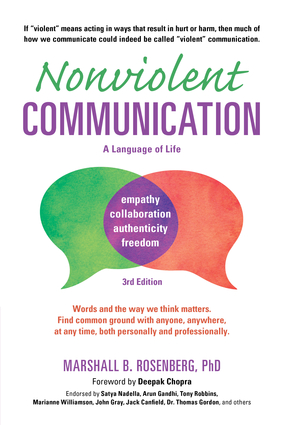

Nonviolent Communication: A Language of Life
Life-Changing Tools for Healthy Relationships
Nonviolent Communication Guides
SELF-HELP
264 Pages, 6 x 9
Formats: Paperback, ebook: PDF, ebook: EPUB, Mobipocket
Paperback, $19.95 (US $19.95) (CA $26.95)
Publication Date: September 2015
ISBN 9781892005281
Overview
What is Violent Communication?
If “violent” means acting in ways that result in hurt or harm, then much of how we communicate—judging others, bullying, having racial bias, blaming, finger pointing, discriminating, speaking without listening, criticizing others or ourselves, name-calling, reacting when angry, using political rhetoric, being defensive or judging who’s “good/bad” or what’s “right/wrong” with people—could indeed be called “violent communication.”
What is Nonviolent Communication?
Nonviolent Communication is the integration of four things:
• Consciousness: a set of principles that support living a life of compassion, collaboration, courage, and authenticity
• Language: understanding how words contribute to connection or distance
• Communication: knowing how to ask for what we want, how to hear others even in disagreement, and how to move toward solutions that work for all
• Means of influence: sharing “power with others” rather than using “power over others”
Nonviolent Communication serves our desire to do three things:
• Increase our ability to live with choice, meaning, and connection
• Connect empathically with self and others to have more satisfying relationships
• Sharing of resources so everyone is able to benefit
Reviews
“Nonviolent Communication connects soul to soul, creating a lot of healing. It is the missing element in what we do.” —Deepak Chopra, author of How To Know God
“Dr. Rosenberg has brought the simplicity of successful communication into the foreground. No matter what issue you’re facing, his strategies for communicating with others will set you up to win every time.” — Anthony Robbins, author, Awaken the Giant Within and Unlimited Power
“Marshall Rosenberg’s dynamic communication techniques transform potential conflicts into peaceful dialogues and create compassionate connections. I highly recommend this book.” — John Gray, Ph.D., author of Men are From Mars, Women are from Venus
"You have to be able to say, 'Where is this person coming from?' he says. 'What makes them tick? Why are they excited or frustrated by something that is happening, whether it’s about computing or beyond computing?' There’s far more to McCracken’s outstanding piece. Nadella gave him a close and honest look at both himself and Microsoft, and the result is a fun must-read." — Ben Kerschberg, Forbes
"Upon becoming Microsoft CEO, Satya Nadella asked his top executives to read Marshall Rosenberg's Nonviolent Communication. . . . If empathy as a measure of emotional IQ is a predictor of success, then Nadella hit the nail on the head by inculcating the corporate giant with the trait from top to bottom. Why else is empathy important? Microsoft is both a services and a product company, and its offerings have to resonate with users. Nadella states: 'You have to be able to say, "Where is this person coming from? What makes them tick? Why are they excited or frustrated by something that is happening, whether it's about computing or beyond computing?"' — Harry McCracken, Fast Company
"The 1 Book That Transformed Microsoft's Culture from Cutthroat to Creative." — Satya Nadella, Microsoft CEO
"Nadella's time as CEO was initially shaped by Marshall Rosenberg's 'Nonviolent Communication,' which he asked his top executives to read. This was the first indicator to senior leadership that Nadella would not operate like his predecessors" — Satya Nadella, Microsoft CEO, Business Insider
"The CEO of Microsoft, the most valuable company in the world, grounds himself and Microsoft's culture on ideas he's learned thanks to his reading habit. ‘I read a few pages here or a few pages there,’ Nadella told Fast Company. ‘There are a few books, of course, that you read end-to-end. But without books I can't live.’ Nadella's time as CEO was initially shaped by Marshall Rosenberg's ‘Nonviolent Communication,’ which he asked his top executives to read. This was the first indicator to senior leadership that Nadella would not operate like his predecessors. Nadella recommended it to his leadership team, symbolically differentiating his expectations from that of his predecessors. Nonviolent communication integrates qualities like compassion and effective communication to allow for better leadership. Rosenberg writes from a position of experience and research: He has started peace programs in places throughout the world that have experienced the effects of war, including Rwanda, Sri Lanka, Serbia, and Ireland. This book outlines the principles of peaceful conflict resolution. It's interesting to note that one of the concepts involves sharing power with others instead of using power over others. Nadella recommended it to his leadership team, symbolically differentiating his expectations from that of his predecessors. Reports have found that Microsoft used to have a conflict-heavy culture under Steve Ballmer — now there's nonviolent communication coming from the top." — Satya Nadella, Microsoft CEO, Business Insider
Author Biography
Marshall B. Rosenberg, PhD founded and was for many years the Director of Educational Services for the Center for Nonviolent Communication, an international peacemaking organization. During his life he authored fifteen books, including the bestselling Nonviolent Communication, which has sold more than one million copies worldwide and has been translated into more than thirty languages.




